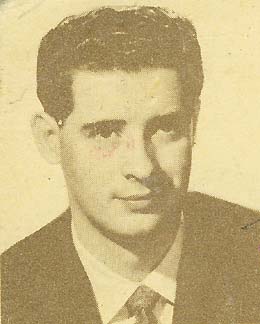Seattle Bandstand was a televised teen-dance show modeled after Dick Clark's national program, American Bandstand and hosted by Ray Briem (b. 1930). The Northwest version is an instant favorite of Northwest youth and eventually helps launch the hit-making careers of several area teen-bands. The show launched on March 16, 1958, and ran until 1961.
Ray Briem on Radio
Ray Briem was raised in Ogden, Utah, where as a junior high student in 1945 he and a few pals conceived of a 15-minute radio show concept called The Adventures of Vivacious Vicky that the town’s tiny 5,000-watt station agreed to air. By fall -- while attending his first year of high school -- he was hired as host of his own weekly Music From Madhouse Manor show.
In 1949 Briem entered the military. He was stationed in New York, and in addition to his short-wave-radio-communications duties, he was assigned to take remote gear out twice a week to Manhattan’s ritziest nightspots and host live shows with America’s premier dance bands including the orchestras led by Harry James, Guy Lombardo, Count Basie, Duke Ellington, Glenn Miller, Woody Herman, and the Dorsey Brothers.
KING Lures Briem to Seattle
During the Korean War (1950-1953), and while based in Salt Lake City, Briem hosted an Armed Forces radio show -- Hometown Mailbag -- that proved to be extremely popular amongst homesick GI’s stationed in Korea and Japan and their families back home. It drew the attention of the radio industry, and around 1957 representatives from Seattle’s King Broadcasting began trying to lure Briem north.
Initially he resisted, but he was finally convinced to visit KING in February 1958. He was intrigued by an offer from station executive Otto Brandt to let him augment an afternoon KING-AM radio DJ shift with a weekly KING-TV show of some sort. Observing that Dick Clark’s Philadelphia-based, nationally broadcast American Bandstand dance-show on ABC-TV was already a big success, KING, an NBC affiliate, agreed and the seed for a new teen dance show was planted.
Seattle Bandstand
Briem gave notice to his Utah job, packed his belongings, and moved north. Planning for Seattle Bandstand then began in earnest. At 1 p.m. on the afternoon of Saturday March 16, 1958, the King Broadcasting Company’s new hire began hosting a weekly two-hour television program that would feature a gaggle of area teens who’d written in to request tickets to participate by dancing to the Top-10 songs of the week -- which Briem touted as the “King Size 10.”
A rather ambitious undertaking. Seattle Bandstand made use of three cameras at the station's studios on at 320 Aurora Avenue N., and was broadcast live (dancing, lip-syncing singers, promotional ads, and all) every Saturday afternoon from 1 p.m. until 3 p.m.
Seattle Bandstand was an instant success -- Northwest teens swamped the station begging to be included. So too did local record distributors wanting to promote new records they were pushing. And local dance and concert producers did likewise, offering to bring touring teen stars through to lip-sync their latest hit and plug an upcoming event.
KING of the Hop
In addition to spinning popular hit singles, Briem introduced the occasional singing stars or rock ‘n’ roll combo. Among the national stars that made appearances on Seattle Bandstand were the famed 1950s vocal pop groups, the Four Freshmen, the De Castro Sisters, the Platters, and the Diamonds. Then along came that parade of early East Coast teen idols like Fabian, Frankie Avalon, and Bobby Darin.
On the night of February 23, 1959, Darin even headlined a Briem-promoted dance at Seattle’s north-end teen mecca, Parker’s Ballroom. Also booked on the bill that night were two of the Northwest’s most promising young groups. Olympia’s Fleetwoods -- who were just then breaking out with their debut local-label single, “Come Softly To Me” (which was soon to become a worldwide No. 1 smash) -- opened the show. Then their label-mates at Seattle’s Dolton Records, the Frantics, performed and backed Darin on his recent hits, “Plain Jane,” “Splish Splash,” and “Queen Of The Hop.” Darin was so keyed up that after his own set he jumped up on the stage again and jammed with the Frantics on Ray Charles’ “I Got A Woman,” and a few additional tunes.
Bandstand’s Last Stand
Seattle Bandstand proved that a regionally oriented teen-dance record hop show (that also supported other Northwest bands like the Wailers, Bluenotes, Shades, Ron Holden and the Thunderbirds, Ventures, and Night People) could be successful -- or “bop-a-roo” as Briem would have said -- and by 1958–1959 it had inspired various other NBC affiliate stations to launch such similar programs such as KNDO-TV’s Yakima Bandstand, KHQ-TV’s Spokane Bandstand, and KGW-TV’s Portland Bandstand.
In February 1960, Ray Briem left KING and another local radio character, Frosty Fowler, took over host duties for Seattle Bandstand. The show carried on through 1961, reportedly shifting at some point to a format where it was pre-recorded on Thursday afternoons and then aired on Saturdays.
Though the show only aired for a few short years, Seattle Bandstand impacted plenty of local teens including Tobias Wolff, who would go on to mention it in his esteemed 1989 book, This Boy’s Life: A Memoir.
Ray Briem went on to a long career in conservative talk radio while based in the So-Cal market. He was ultimately honored for his contributions to radio with a bronze star in the famed Hollywood Walk of Fame.

